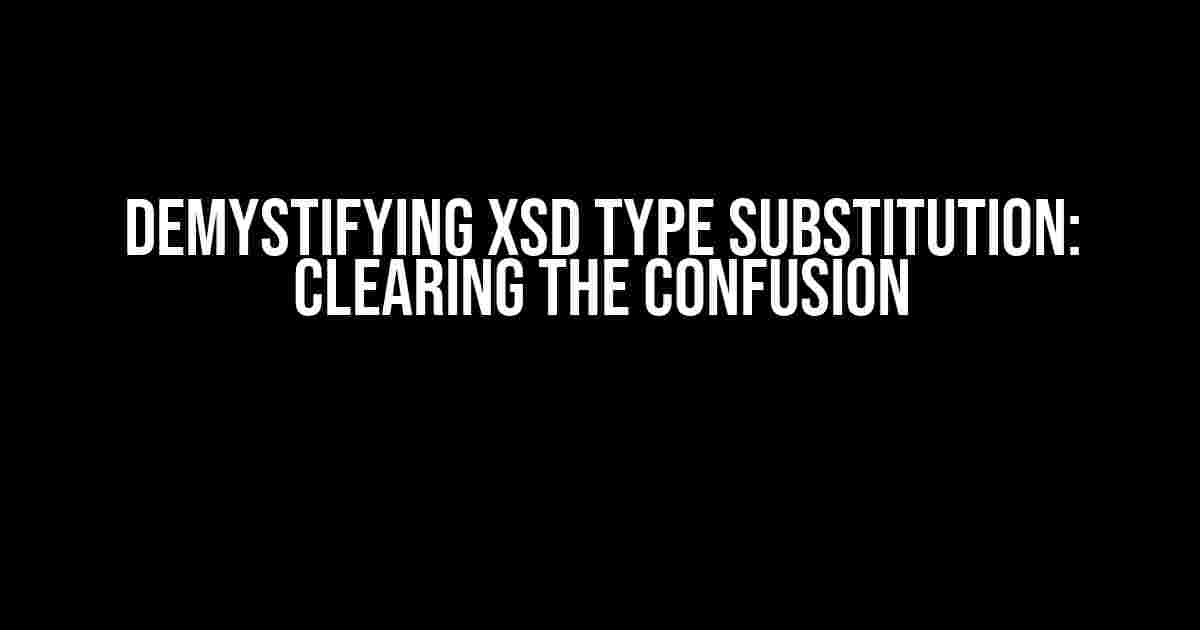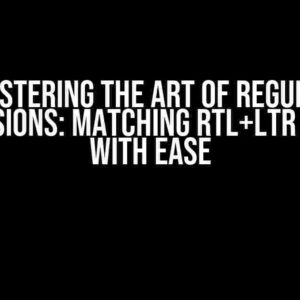XML Schema Definition (XSD) is a powerful tool for defining the structure and constraints of XML documents. However, one of the most misunderstood and often confusing aspects of XSD is type substitution. In this article, we’ll delve into the world of XSD type substitution, debunking common myths and providing clear, step-by-step instructions to help you master this complex topic.
What is XSD Type Substitution?
Type substitution is a mechanism in XSD that allows you to substitute one data type with another, while maintaining the integrity of the original data. This can be useful when you need to create a new type that inherits the properties of an existing type, but with some modifications.
The Basics: Substitution Groups and Type Derivation
Before we dive into the details of type substitution, it’s essential to understand the two fundamental concepts: substitution groups and type derivation.
A substitution group is a set of elements that can be used interchangeably in an XML document. This means that an element from one substitution group can be replaced by an element from another substitution group, as long as they share the same type.
Type derivation, on the other hand, is the process of creating a new type based on an existing type. There are two types of derivation: restriction and extension.
- Restriction: Redefines an existing type by restricting its content.
- Extension: Inherits the properties of an existing type and adds new features.
The Confusion: Understanding Type Substitution in Practice
Now that we’ve covered the basics, let’s explore some common scenarios that can lead to confusion when working with type substitution.
Scenario 1: Substitution Groups and Type Derivation
Suppose we have an XSD schema with two types: Vehicle and Car. We want to create a new type, SportsCar, which is a specialization of Car.
<xs:complexType name="Vehicle">
<xs:sequence>
<xs:element name="make" type="xs:string"/>
<xs:element name="model" type="xs:string"/>
</xs:sequence>
</xs:complexType>
<xs:complexType name="Car">
<xs:complexContent>
<xs:extension base="Vehicle">
<xs:sequence>
<xs:element name="engine" type="xs:string"/>
</xs:sequence>
</xs:extension>
</xs:complexContent>
</xs:complexType>
<xs:complexType name="SportsCar">
<xs:complexContent>
<xs:extension base="Car">
<xs:sequence>
<xs:element name="turbo" type="xs:boolean"/>
</xs:sequence>
</xs:extension>
</xs:complexContent>
</xs:complexType>
In this example, SportsCar is a specialization of Car, which is itself a specialization of Vehicle. This creates a type hierarchy, where SportsCar inherits the properties of both Car and Vehicle.
Scenario 2: Element Substitution
Now, let’s consider a scenario where we want to substitute an element with another element from a different substitution group.
<xs:element name="vehicle" type="Vehicle"/> <xs:element name="car" substitutionGroup="vehicle" type="Car"/> <xs:element name="sportsCar" substitutionGroup="car" type="SportsCar"/>
In this example, we’ve defined three elements: vehicle, car, and sportsCar. The car element is a member of the vehicle substitution group, and the sportsCar element is a member of the car substitution group.
This means that an instance of sportsCar can be used wherever an instance of vehicle or car is expected.
Best Practices for Controlling Type Substitution
To avoid confusion and ensure proper type substitution, follow these best practices:
- Use clear and descriptive type names: Avoid using generic type names like
type1ormyType. Instead, use descriptive names that reflect the purpose and structure of the type. - Document your type hierarchy: Use comments and annotations to document the relationships between types and their substitution groups.
- Test your schema thoroughly: Verify that your schema is working as expected by testing it against sample XML instances.
- Use tools and validators: Utilize tools like XML validators and schema analyzers to ensure that your schema is correct and consistent.
- Keep your schema modular: Break down large schemas into smaller, more manageable modules to reduce complexity and improve maintainability.
Common Pitfalls to Avoid
When working with type substitution, it’s easy to fall into common pitfalls that can lead to confusion and errors. Here are some common mistakes to avoid:
- Inconsistent type naming: Using inconsistent or unclear type names can lead to confusion and errors.
- Overly complex type hierarchies: Deeply nested type hierarchies can be difficult to understand and maintain.
- Insufficient testing: Failing to thoroughly test your schema can lead to unexpected behavior and errors.
- Failing to document type relationships: Omitting documentation about type relationships can make it difficult for others to understand and maintain your schema.
Conclusion
Type substitution is a powerful feature in XSD that allows you to create flexible and reusable schema definitions. However, it can be confusing and prone to errors if not used carefully. By following best practices, avoiding common pitfalls, and understanding the basics of substitution groups and type derivation, you can master the art of controlling type substitution and create robust, maintainable XSD schemas.
| Scenario | Type Hierarchy | |
|---|---|---|
| Vehicle → Car → SportsCar | Vehicle → Car → SportsCar | vehicle → car → sportsCar |
By following the guidelines outlined in this article, you’ll be well on your way to demystifying XSD type substitution and creating robust, maintainable schema definitions.
Frequently Asked Question
XSD type substitution got you feeling lost? Don’t worry, we’ve got the answers to get you back on track!
What is XSD type substitution, and why is it so confusing?
XSD type substitution is a feature in XML Schema that allows you to substitute one type with another in an instance document. It’s like a alias for your data types! However, it can get confusing because it doesn’t follow the traditional object-oriented inheritance model. Think of it more like a ” duck typing” approach, where the focus is on the structure of the data rather than its class hierarchy.
How do I control type substitution in XSD?
You can control type substitution by using the xsi:type attribute in your XML instance document. This attribute specifies the type of the element or attribute being declared. You can also use the xsd:alternative attribute in your XSD schema to specify alternative types for an element or attribute. Additionally, you can use xsd:substitutionGroup to define a group of types that can be substituted for each other.
What’s the difference between xsd:extension and xsd:restriction in XSD type substitution?
xsd:extension is used to extend an existing type by adding new elements or attributes, while xsd:restriction is used to restrict an existing type by limiting its content model. Think of extension as “adding more” and restriction as “removing or limiting”. When you extend a type, you’re creating a new type that includes all the elements and attributes of the original type, plus some additional ones. When you restrict a type, you’re creating a new type that includes only a subset of the elements and attributes of the original type.
Can I use type substitution with anonymous types in XSD?
The short answer is: it’s complicated! Anonymous types in XSD are types that are defined inline within an element or attribute declaration, rather than being defined as a separate type. While it is possible to use type substitution with anonymous types, it’s not always straightforward and can lead to confusion. In general, it’s recommended to avoid using anonymous types whenever possible and instead define separate named types to make your schema more readable and maintainable.
How can I avoid common pitfalls when using XSD type substitution?
To avoid common pitfalls, make sure you thoroughly understand the XSD type system and the implications of type substitution. Use clear and descriptive names for your types and elements, and avoid using anonymous types whenever possible. Also, be careful when using xsi:type, as it can lead to unexpected behavior if not used correctly. Finally, test your schema thoroughly to ensure that it behaves as expected and doesn’t lead to validation errors.




